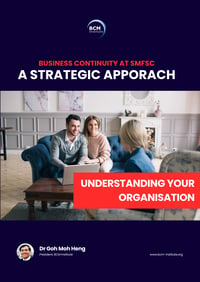eBook 1: Chapter 1
![BCM [E1] [C1] Overview of BCM Case Study Banner](https://blog.bcm-institute.org/hs-fs/hubfs/BCM%20E1%20Blog%20Banner/BCM%20%5BE1%5D%20%5BC1%5D%20Overview%20of%20BCM%20Case%20Study%20Banner.png?width=1920&height=384&name=BCM%20%5BE1%5D%20%5BC1%5D%20Overview%20of%20BCM%20Case%20Study%20Banner.png)
Understanding Your Organisation for SIT
In today’s dynamic, technology-driven educational landscape, the ability to sustain operations amid disruptions has become a defining measure of institutional resilience.
The Singapore Institute of Technology (SIT), Singapore’s university of applied learning, recognises that ensuring uninterrupted teaching, learning, and research activities is not only an operational imperative but also a reflection of its commitment to students, faculty, and partners.
The recent global disruptions—from pandemics to cyber threats and infrastructure outages—have underscored the importance of a robust Business Continuity Management (BCM) framework that safeguards learning continuity and institutional integrity.
This eBook 1 "Understanding Your Organisation for SIT", is part of the series of eBooks “Safeguarding Learning Continuity: The Business Continuity Management Journey of the Singapore Institute of Technology,” documents SIT’s comprehensive journey in implementing a structured BCM program that aligns with ISO 22301:2019 – Security and resilience – Business continuity management systems – Requirements.
The initiative reflects SIT’s strategic commitment to building a resilient organisation capable of withstanding disruptions while maintaining critical academic and administrative functions.
The eBook is divided into two major sections designed to provide both conceptual understanding and practical application.
Structure of the eBook
The eBook is organised into two comprehensive sections:
eBook 1: Understanding Your Organisation
This section introduces readers to SIT’s organisational context, focusing on its operating environment, mission, and critical functions that support its education, research, and industry engagement.
It explores how SIT established its BCM goals, objectives, and assumptions, formed its BCM team, and assessed risks and threats relevant to its unique academic ecosystem.
It concludes by identifying SIT’s critical business functions that ensure academic continuity, student experience, and institutional governance.
Topics covered include:
- Introducing BCM for the Singapore Institute of Technology (SIT)
A primer on the principles and value of BCM in SIT’s operational context. - Understanding SIT’s Operations
A detailed overview of the organisation’s structure, service delivery models, stakeholders, and support functions. - Identifying BCM Goals
Clarifying the outcomes SIT seeks to achieve through continuity planning. - Establishing BC Objectives
Setting measurable and achievable continuity targets aligned with service mandates. - Determining BC Assumptions
Identifying realistic assumptions that will guide planning decisions. - Developing the BCM Team Composition
Defining roles and responsibilities for key individuals involved in BCM implementation and execution. - Analysing the Operating Environment
Reviewing the internal and external environment, including technology, partnerships, and regulatory dependencies. - Implementing the BCM Planning Methodology
Introducing the seven-phase methodology that will be applied in Section 2. - Assessing Risks and Threats
Identifying potential disruptions and threats to continuity based on SMFSC’s unique operating profile. - Identifying Critical Business Functions
Recognising processes and services that must be prioritised during a disruption.
eBook 2: Implementing Business Continuity Management for SIT
Implementing Business Continuity Management for the Singapore Institute of Technology.
Building upon the foundation established in Section 1, this section provides a detailed walkthrough of SIT’s implementation of the BCM Planning Methodology, structured across seven distinct phases:
- Project Management (PM): Establishing governance, scope, and stakeholder alignment.
- Risk Analysis and Review (RAR): Identifying and evaluating risks relevant to SIT’s service delivery.
- Business Impact Analysis (BIA): Determining the impact of disruptions on critical services and setting recovery priorities.
- Business Continuity Strategy (BCS): Developing strategies to sustain or recover key functions.
- Plan Development (PD): Creating detailed response and recovery plans.
- Testing and Exercising (TE): Validating the plans through simulations and drills.
- Program Management (PgM): Maintaining and continuously improving the BCM programme over time.
Target Audience
This eBook is intended for:
- SIT leaders and managers are responsible for safeguarding service delivery and staff readiness.
- Administrative and support staff play a key role in operational resilience.
- Partner agencies collaborate with SIT in providing holistic support.
![[BCM] [Thin Banner] Summing Up](https://blog.bcm-institute.org/hs-fs/hubfs/BCM%20Generic%20Banner/%5BBCM%5D%20%5BThin%20Banner%5D%20Summing%20Up.png?width=1920&height=250&name=%5BBCM%5D%20%5BThin%20Banner%5D%20Summing%20Up.png)
The Singapore Institute of Technology’s BCM journey represents more than a compliance initiative—it is a strategic pursuit of resilience in higher education.
By aligning with ISO 22301 standards and applying a structured BCM methodology, SIT has established a strong foundation to anticipate, respond to, and recover from disruptions without compromising its core mission of applied learning and innovation.
As SIT continues to grow its academic and industry partnerships, its BCM framework ensures that resilience becomes an institutional culture rather than a one-time project.
The lessons captured in this eBook are intended to guide other educational institutions in adopting a systematic approach to continuity planning—transforming challenges into opportunities for operational excellence and sustainable learning continuity.
Ultimately, “Safeguarding Learning Continuity” is not just about protecting operations; it is about preserving the trust of students, faculty, and society in SIT’s ability to deliver on its mission, regardless of the circumstances.
More Information About Business Continuity Management Courses

 To learn more about the course and schedule, click the buttons below for the BCM-300 Business Continuity Management Implementer [B-3] course and the BCM-5000 Business Continuity Management Expert Implementer [B-5].
To learn more about the course and schedule, click the buttons below for the BCM-300 Business Continuity Management Implementer [B-3] course and the BCM-5000 Business Continuity Management Expert Implementer [B-5].
![Register [BL-B-3]*](https://no-cache.hubspot.com/cta/default/3893111/ac6cf073-4cdd-4541-91ed-889f731d5076.png) |
 |
 |
 |
 |
 |
![FAQ [BL-B-3]](https://no-cache.hubspot.com/cta/default/3893111/b3824ba1-7aa1-4eb6-bef8-94f57121c5ae.png) |
If you have any questions, click to contact us.
|
 |
 |
 |
 |




![Email to Sales Team [BCM Institute]](https://no-cache.hubspot.com/cta/default/3893111/3c53daeb-2836-4843-b0e0-645baee2ab9e.png)

